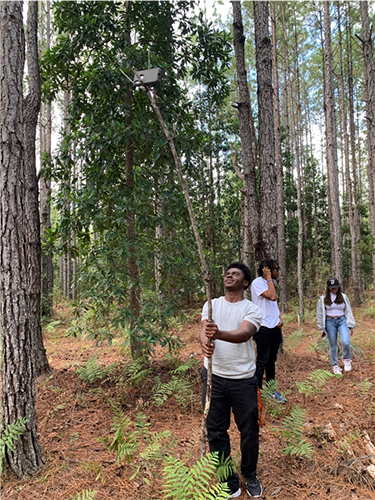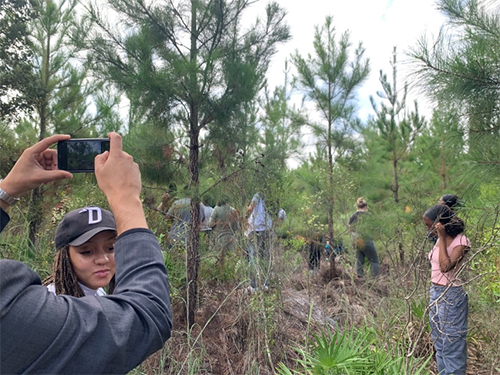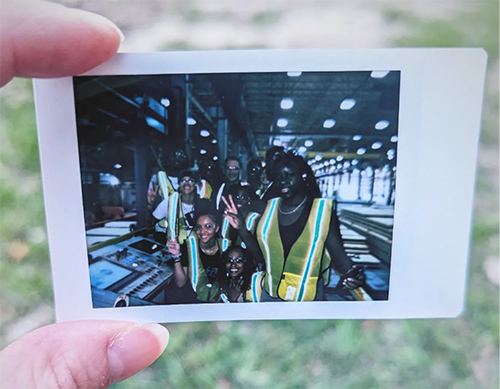Earlier this fall, I had an amazing day at the Austin Carey Forest Campus, which is part of the University of Florida in Gainesville. The morning consisted of a tour of the 2,000-acre Austin Carey Forest in the company of nearly 40 architecture students from the University of Miami School of Architecture and Florida Agricultural and Mechanical University. We inspected and learned about various managed sections in the forest.
The afternoon consisted of presentations, including me giving one on SFI. The new SFI Urban and Community Forest Sustainability Standard generated particular interest in a room full of students studying ways to transform how we live and work in cities.

Many of the students I met are benefitting from an SFI Community Grant. Through this grant, SFI, the University of Miami’s School of Architecture, and Florida Agricultural and Mechanical University (FAMU) are working to foster understanding among architecture students about the climate-related benefits of choosing building materials from sustainably managed forests. The grant-supported project is giving architecture students access to a range of forest-focused activities, including touring well-managed forests full of standing timber and regional manufacturing facilities that are producing mass timber. The information offered to students, faculty, and related professionals is directly applicable to the practice of architecture and is designed to increase the uptake of certified forest products.
FAMU, a historically Black university, has a rich legacy and historic mission of educating and meeting the needs of future generations in Florida and beyond. The SFI community grant supports underrepresented students of architecture attending FAMU through financial assistance to learn about and experience the various phases of timber production and manufacturing. This will help prepare them to become sustainable forestry advocates and leaders within the architecture industry.
There was plenty of leadership on display during my day with the students. I was impressed with their ability to link sustainable forestry to innovative building products and designs that, in turn, offer chances to mitigate climate change by sequestering carbon. A lot of the students, most of whom are from urban settings, said that visiting the forest was like “going to the source.” Other students made the connection from “forest to design” in the same way rural advocates talk about “from farm to table.”
Some students loved the forest, others confessed they “don’t like nature,” but a day in the forest seemed to soften this line of thinking. There was also time for some fun as one student happily showed a giant spider to classmates.
The day before the forest tour, the students toured SFI‑certified companies SmartLam and Rex Lumber. They were amazed at the production process.
SmartLam’s production facility in Dothan, Alabama, was the first manufacturer to offer Southern Yellow Pine cross-laminated timber (CLT) products in the US. This 225,000 square-foot plant is state-of-the-art and can produce over two million cubic feet of lumber. SmartLam’s CLT panel grades and thicknesses are composed of a combination of species, lumber strength, and lumber thicknesses to optimize structural performance and ensure the most cost-effective solution. The students were interested to learn that SmartLam offers proprietary panel recipes for specific building needs.
At the Rex Lumber plant in Dothan, Alabama, students learned that while using solid hardwood lumber is an inherently green choice, forest certification is important for maintaining the confidence of the public in today’s lumber industry. The importance of green building standards designed to produce more efficient, low-impact construction was of particular interest to the students. Rex Lumber products can be used in structures seeking certification by LEED, Green Globes, and other initiatives.


My day with the students reminded me that too many architecture students have limited opportunities to learn about the environmental benefits of using forest-based building materials. This can lead them to choose more carbon-intensive building products for their design projects after graduation. But the future is bright — my time in a beautiful Florida forest with these engaging architecture students left me feeling excited about what this new generation of design and climate leaders will accomplish.
